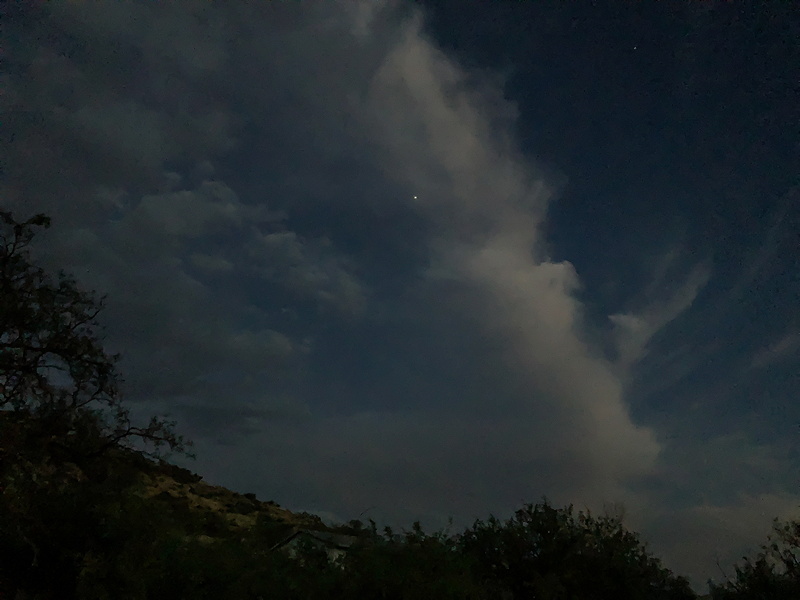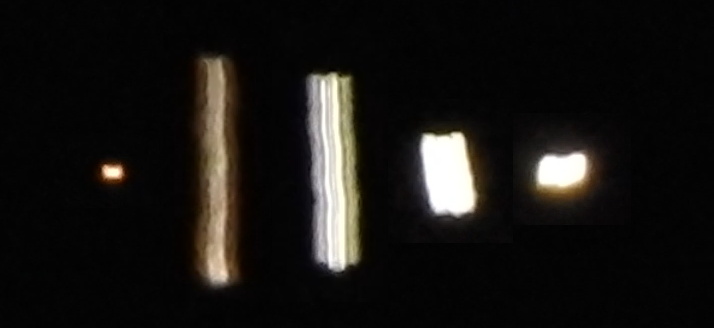Cloudy Sky; Coolpix P900 Setting Sun, ISS
Posted: 10 June 2018
Saturday, 9 June 2018, dawned clear, but by 0800 MST pre-Monsoon Season clouds began appearing in the southeastern sky. Due to the unstable weather pattern, the forecasts for the night began fluctuating: cloudy, then clear with lightning, to cloudy with lightning. The sky was mostly cloudy by late afternoon and the wind picked up. I decided to go to the observatory anyway in case the sky was clear enough to view an excellent pass of the International Space Station, which I wanted to image again with the Nikon Coolpix P900 camera.
|
Open: Saturday, 9 June 2018, 1922 MST Temperature: 85°F |
Session: 1248 Conditions: Mostly cloudy, breezy |
Equipment Used:
Camera:
Coolpix P900
iPhone 8 Plus
I opened the observatory dome but did not use the 12" LX600 telescope this session due to the cloudy sky.
I decided to monitor the clouds from the observatory patio bench while waiting for the ISS pass to begin at 2032 MST.
As the Sun began to set I moved to higher ground to get a good view of the western horizon. I took the following autoexposure photos (cropped vertically) of the setting Sun using the Coolpix P900 camera at a focal length of 2000mm (35mm equivalent):



1933 MST: sunset.
I then returned to the observatory patio to watch the clouds. 1958 MST: this was how the western sky appeared. The planet Venus is in the center of the iPhone 8 Plus photo.

2011 MST: the southeast sky looked like this. The planet Jupiter is above center (iPhone 8 Plus).

2020 MST: a hole in the clouds was approaching where the ISS would cross the sky. This gave me some confidence that I would be able to do another test of the P900 on the ISS. The previous test had the ISS overexposed. This test would be using f/6.5, 1/1000sec, ISO 400, FL 2000mm (35mm equivalent). Handheld tracking of the ISS would be more challenging this time as the pass would be near the zenith, and hence show its "fastest" motion across the sky.
2024 MST: Kissing Bug terminated.
The ISS did pass through a mostly clear area of the sky. As expected, tracking was challenging. In fact, it was nearly impossible to keep the ISS in the camera field-of-view (FL 2000mm) when it was higher than about 30° above the horizon. The following image shows five frames with the ISS from the nearly five minutes of video. The left image is of the ISS low in the sky shortly after the pass began. The next images are as the ISS approached and then passed the zenith. Although camera motion blurred the ISS, the solar panels are visible. And yes, the ISS was still overexposed.

There is one more opportunity coming up (11 June) to try another P900 test. I plan to use f/6.5, 1/4000sec, ISO 400, FL 2000mm, for that test. The faster shutter speed should help with the exposure and reduce the effects of camera motion (I hope). The ISS will not be as bright for the next pass as it was this night and it will stay lower in the sky.
|
Close: Saturday, 9 June 2018, 2049 MST Temperature: 83°F |
Session Length: 1h 27m Conditions: Partly cloudy |
Comments are welcome using Email. Twitter users can use the button below to tweet this report to their followers. Thanks.
Cassiopeia Observatory Home Page
Copyright ©2018 Michael L. Weasner / mweasner@me.com
URL = http://www.weasner.com/co/Reports/2018/06/10/index.html
